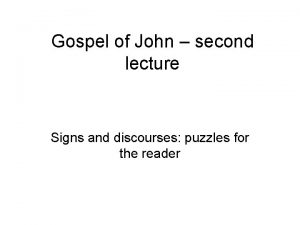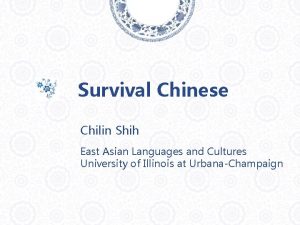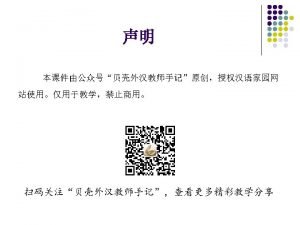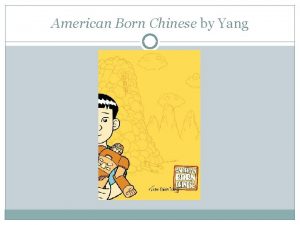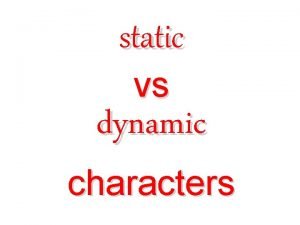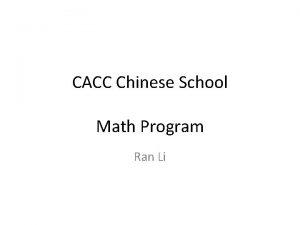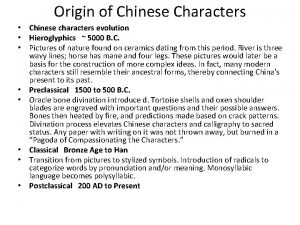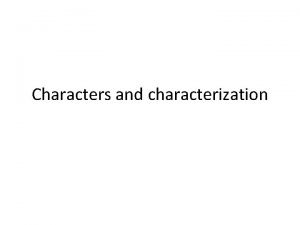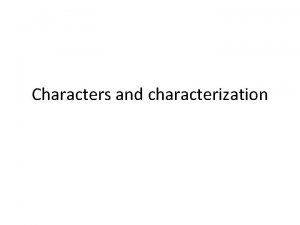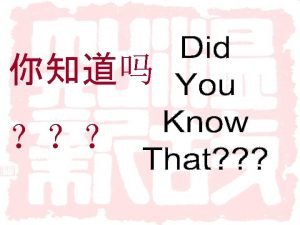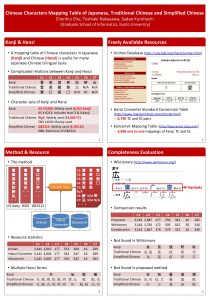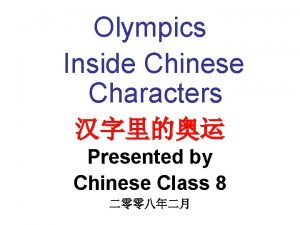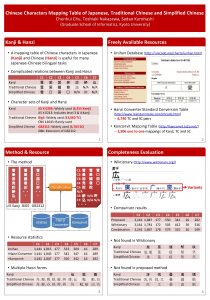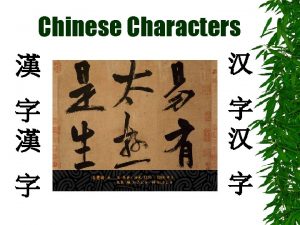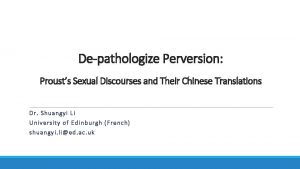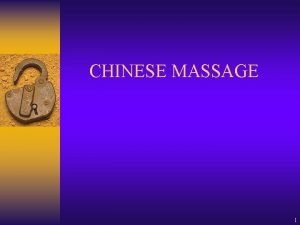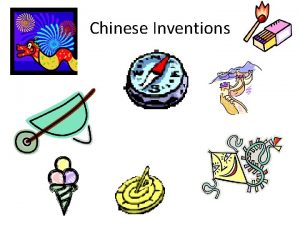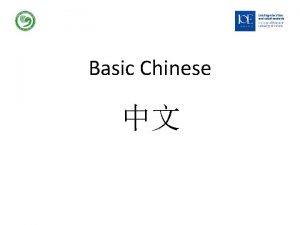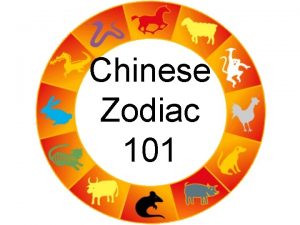Teaching Chinese in American School Discourses Characters vs




































- Slides: 36

Teaching Chinese in American School Discourses: Characters vs. Pinyin Dr. Huihong Bao Saint Edward’s School 1895 Saint Edward’s Drive, Vero Beach, FL 32963 Email: hbao@steds. org

Why Teaching/Learning Chinese? • 1. 4 native Chinese speakers

Which Language has the most speakers?




Why Chinese? • Chinese: one of the four critical world languages Chinese, Arabic, Russian & Farci/Persian(波斯语) • China: the world’s oldest & richest continuous cultures, over 5000 years old the most populous nation in the world (almost 1. 4 billion) 1/5 of the planet speaks Chinese. Mandarin Chinese is the mother tongue of over 873 million people, making it the most widely spoken L 1 in the world. • It’s spoken in Mainland China, Taiwan, Indonesia, Thailand, Malaysia, Singapore, Brunei (文莱), the Philippines, and Mongolia. • Economically important: China: the 2 nd largest economy in the world. China: one of largest trading partners of U. S. Many US companies do business and have long-term investments in China.

You Can Communicate with over a Billion People in Chinese

What are the challenges to teach Chinese to the students with no Chinese background at home & in the community? •

Challenges? • As Chinese teachers teaching in American school discourses, we all face challenges as the majority of our students do not have any Chinese background at home nor in their community. Some teachers choose to focus on teaching characters while others prefer to teach Pinyin only. • The tones are hard to master & the characters are not easy to write and hard to retain in the brains without being frequently reinforced at home or in the community. • What do researchers say about teaching characters and what do they say about teaching Pinyin only?


Our School Foreign Languages’ Program • Spanish: starts from Pre-K, required for every student • Chinese: previously from 8 th grade on, then 7 th grade, optional. If a student wants to take Chinese, he/she has to take Spanish. A student can’t drop Spanish to take Chinese in 7 th and 8 th grade. • In 2018, Chinese is offered two 45 minutes per week (90 minutes/week) to 5 th grade students at our Lower School. • Challenge: I am obliged to make my class super interesting and engaging. • School plan: no grade track for 5 th graders, which might not be a good motivation. • My efforts: Trying various ways to let the ss stay engaged and interested. Organize Chinese New Year celebration (engage all ss) Organize trips to interact with native Chinese speakers Take ss to the annual FL State Chinese competition Teaching ss how to cook Chinese food (scallion cake, Jiaozi, chun juan, baozi) Organize Pingpang club to provide opportunities for Chinese language learners to interact with native Chinese ss/international students

Background • My Personal Background Studied EFL teaching methodologies & Teaching EFL at a college level in China. Majored in ESL/Bilingual/Multicultural Education in SOE in UMass Amherst Teaching Chinese at American schools at all levels (at college, kindergarten, middle and high school levels) Majoring in language, literacy and culture for Ed. D. degree MA licensed Chinese/ESL teacher 2009 Nat Geo Certified in May, 2018 Currently teach at Saint Edward’s School • Personal methodology/approach shift: from complete Chinese characters at the very beginning to characters and Pinyin and with Immersion Approach at beginning level • Character with pinyin for new characters for intermediate and advanced level

Chinese Teaching in American School Discourses • Star. Talk Programs: Nebraska Univ. Lincoln 2015 Troy University in Alabama 2017 The Bangor Chinese School in Maine 2018 What other teachers are doing: Those who attended Startalk Program Emphasizing on training students’ listening and speaking competence Less talked about is reading and writing, particularly writing American born Chinese teachers or non Chinese native Teachers: focus on Pinyin In some schools: characters only • What does each professional colleague here use, complete Pinyin or Complete characters? (survey on the spot)

Star. Talk Programs • Backward Design: to set up the learning goals/can-do statements upfront and all the learning activities are focused on reaching these goals. 6 Principles of L 2 Teaching: • Implementing standards-based and thematically-organized curriculum • Integrating language, literacy and content into the classroom • Using performance-based assessment • Creating a student-centered classroom • Staying in target language & using comprehensible input • Using age-appropriate authentic material Startalk website: https: //startalk. umd. edu/public/ Free Federal-funded summer program for teachers and students. Arabic, Chinese, Dari, Hindi, Korean, Persian, Portuguese, Russian, Swahili, Turkish, Urdu, etc.

Star. Talk Approach • Focus on communicative competence, which is good for beginners. • As to higher level students’ literacy skills, they have not figured out a specific effective way to help students achieve their L 2 proficiency goal yet. • Question: how to effectively help higher level students go up a higher level needs to be explored and researched.

Advantages and Disadvantages of Learning Pinyin

Advantages of Learning Pinyin • Pinyin helps students to pronounce a word properly. • Using pinyin allows beginners to start speaking Chinese quickly. • The tone marks in pinyin are visual reminders. • Learning with pinyin is more similar to learning languages with Roman letters. • Once you learn pinyin, you can begin to type Chinese on a computer. Pinyin input system is a lot easier. • Pinyin as a building block

Disadvantages of Using Pinyin • When ss learn with pinyin, it is very easy to become dependent and keep them away from learning characters, which will eventually hurt their literacy development. • The pinyin for a word changes sometimes, depending on the context. 着(zhao)急 找着 (zhao )了 挂着 (zhe) • So many words have the exact same pinyin (homophone). Learners easily get confused about which word somebody has written if you have only learned pinyin. | yóuyú: 由于(because of) and �� (squid) chénmò: 沉默(silent) and 沉没(to sink) jìyì: �� (remember) and 技� (skill; art) yuányīn: 原因(reason, origin) and 元音(vowel) jiāodài: 交代 or 交待(to hand over; to explain; to make clear) and 胶� (tape) • Pinyin pronunciation is not intuitive. • Characters helps make connections. • Learning Pinyin only for students having no target language background results in little progress and a lot of repetitive learning.

Advantages and Disadvantages of Learning Characters

Advantages of Teaching characters • • • Consistent written form: 我说,你听,她看。 Meaning remains the same across languages 我 去 走 Some characters show the meaning:森林 美 好 Chinese is composed of pictograms and semi-phonetic ideograms. 妈 饿 粮 Chinese has no tenses, no cases, no genders and simple grammar 做 vs. do/did/done When it comes to the issue of grammatical complexity, Chinese is really one of the easiest languages is to learn. Subj+ V. obj. Most commonly used characters are around 2, 500 to 3, 000. With this vocabulary, one can survive very well in a Chinese speaking world. Computer-assisted learning is making learning Chinese easy and fun Chinese opens up a world of opportunity for its learners Chinese skills are rare, and can make a learner an attractive hire Ss literacy skills get increased and leading to increase reading and writing skills) Phrases are made up of characters that are known to the students. 课, 下课, 上课, 功课,课 本 ……

2 & 3 trees do make a forest. Characters make meanings.

Disadvantages of Learning Characters • It is hard for the students whose L 1 is a Roman language as Chinese characters themselves have no connection with their sounds. From the characters, one can’t figure out how to read/pronounce the character. • There are many homophones , i. e. words with the same sounds/pronunciation, so it is hard for students to make a clear distinction between these words. • It requires step-by-step persistent efforts to internalize the basic commonly used 2, 500 to 3, 000 characters. Hard work needs to be put in for literacy. • The writing of the characters are hard because the formation of most characters are not based on logic. • Ss get frustrated with some seemingly confusing characters. 士 /土 未/末 我 / 找 主 /王 兵/� /� 卬 (ÁNG)/ 印/ 卯 戊 WÙ/ 戍 (SHÙ)/ 戌 (XŪ) /戎 (RÓNG( 己/已/巳 (SÌ). . . 哀 /衰 /衷

The most Complicated Chinese Character (56 strokes) •

biang mian http: //lexingtonmandarin. weebly. com/blog/pingyao


Facts about Learning the Chinese Language • Data of the Defense Language Institute (DLI) & the Foreign Service Institute (FSI), it takes L 1 English speakers at least three times longer to learn Chinese than to learn French or Spanish. • According to FSI’s list of languages, Chinese is ranked as the most difficult language for L 1 English speakers to master (Stevens, 2006). • Zhao (2008) emphasizes that the success of the CFL instruction depends to a large extent on the effectiveness of Chinese character teaching. Due to the challenging nature of Chinese characters for non-native Chinese language learners (NNCLLs), especially learners whose L 1 corresponds with an alphabetic orthographic form, when and how to introduce Chinese characters to CFL learners have become essential issues within CFL educational research.

Facts about Learning the Chinese Language Chinese has a relatively uncomplicated grammar. Unlike French, German or English, Chinese has no verb conjugation (no need to memorize verb tenses!) and no noun declension (e. g. , gender and number distinctions). For example, while someone learning English has to learn different verb forms like “see/saw/seen, ” all you need to do in Chinese is just to remember one word: kan. 看。 While in English you have to distinguish between “cat” and “cats, ” in Chinese there is only one form: mao, 猫. (Chinese conveys these distinctions of tense and number in other ways, of course. )

Two Common Structures to introduce or delay the learning of characters • With respect to the issue of when to introduce Chinese characters into beginning -level CFL curricula, two common program structures have been advanced. Structure 1: to delay the learning of Chinese characters by substituting the use of Pinyin instead (Everson, 1988, 1994; Mc. Ginnis, 1999; Packard, 1990; Unger et al. , 1993; Walker, 1984, 1989). Pinyin is a Romanized transcription of Chinese. Structure 2: to propose that Chinese characters should be introduced and taught from the beginning of CFL instruction (Liu, 1983).

Theoretical Framework on Structure 1 • Speech Primacy Theory: Educators who support the first structure seem influenced by speech primacy theory, which states that students must have developed substantial oral and aural skills prior to the start to literacy instruction (Dew, 2005; Jorden & Walton, 1989; Swihart, 2004; Unger et al. 1993; Zhang, 2005). This position reflects ways in which children learn their L 1. Those who accept a speech primacy theory believe that the DCI (Delayed character learning) can help CFL students first establish a solid foundation in the spoken language. It allows learners to avoid spending excessive time and energy on the complex orthography of Chinese while initially acquiring speaking and listening skills. Two experimental studies, Everson (1988) and Packard (1990), examined the issue of learning characters in the beginning-level CFL courses. Packard found that “providing students with a grace period before characters are introduced into the elementary Chinese curriculum is beneficial to the second language acquisition of Chinese” (Packard, 1990, p. 174).

Theoretical Framework on Structure 2 • Supporters of structure 2 argue that characters should be taught concurrently with the regular CFL curriculum (and most of the current CFL programs actually do teach reading, writing, speaking, and listening skills concurrently) (Liu, 1983). So far there have been no studies that have documented advantages for the introduction of Chinese characters at the beginning of CFL courses.

JFL Studies • A few related studies about the Japanese writing system in the field of Japanese as a foreign language (JFL) teaching. These studies, point out some disadvantages in the DCI from different perspectives. Hayashi (2009) observed that when learners were not taught kanji from the beginning of a JFL course, learners might show resistance towards kanji learning when they moved to higher-level courses. Not only do researchers and educators hold different opinions toward the timing of introducing characters to beginning-level learners, teachers and learners are also reported to hold different beliefs about when to teach and learn characters. Dewey (2004), in his study of connections between teacher and student attitudes regarding script choice in first-year JFL classrooms, reported the following opposite beliefs by two JFL teacher interviewees: could save JFL students’ time by establishing the sound-visual decoding system. Okita (1997) surveyed JFL learners’ beliefs and found that around 70% of the students wanted to learn standard Japanese orthography from the beginning of instruction.

What would you think of character teaching? To Teach or Not to Teach? • DCL/ to teach Pinyin only or • To teach characters at the very beginning/ICL

What would I propose? • Elementary school students: Pinyin expressions first (DCL) for about several months to one year depending on the learners’ motivation and attitude • Middle school students without heritage speakers: DCL for a while and then characters and Pinyin together • Middle school students with more than half of heritage speakers: Structure 2, to introduce characters upfront • High school students: highly-motivated class: to teach characters upfront as they need to develop 4 skills of the Chinese language for AP Chinese exam (each counts as %25 Less-motivated class: DCL for a while and then introduce characters

Pinyin/DCL or ICL?

Bibliographies Everson, M. E. (1988). Speed and comprehension in reading Chinese: Romanization vs. characters revisited. Journal of Chinese Language Teachers Association, 23(2), 1 -15. Mc. Tighe, J. , & Wiggins, G. (2004). Understanding by design: Professional development workbook. Alexandria, VA: Association for Supervision & Curriculum Development. Unger, J. M. , Lorish, F. C. , Noda, M. , & Wada, Y. (1993). A framework for introductory Japanese language curricula in American high schools and colleges. Washington, DC: The National Foreign Language Center. Walker, G. (1984). ‘Literacy’ and ‘reading’ in a Chinese language program. Journal of Chinese Language Teachers Association, 19(1), 67 -84. Walker, G. (1989). The Less Commonly Taught Languages in the context of American pedagogy. In H. Lepke (Ed. ), Shaping the future: Challenges and Opportunities (pp. 111 -137). Middlebury, VT: Northeast Conference. Wiggins, G. , & Mc. Tighe, J. (2011). What is backward design? Understanding by design, 7 -19. Ye, Lijuan (2011). Teaching and Learning Chinese as a Foreign Language in the United States: To Delay or Not to Delay the Character Introduction Dissertation Georgia State University Zhao, J. (2008). Concept and mode of teaching Chinese as a second language. Chinese Teaching in the World, 1, 93 -107 (in Chinese, with English abstract). https: //en. wikipedia. org/wiki/Biangbiang_noodles#/media/File: Bi%C 3%A 1 ngorder_complete. gif
 Dominant discourses
Dominant discourses New discourses
New discourses 7 discourses in john
7 discourses in john Mathew chapter 5
Mathew chapter 5 Anglo chinese school
Anglo chinese school Chinese chess characters
Chinese chess characters Chilin shih
Chilin shih Horizontal
Horizontal American born chinese anticipation guide
American born chinese anticipation guide American born chinese analysis
American born chinese analysis Amy tan biography
Amy tan biography Sancar flats
Sancar flats Micro teaching meaning
Micro teaching meaning Character
Character Teaching american history grant
Teaching american history grant Teaching american history project
Teaching american history project Tall tale characters
Tall tale characters American gothic characteristics
American gothic characteristics Primary school leaving examination in chinese
Primary school leaving examination in chinese Cacc chinese school
Cacc chinese school Teaching web design to high school students
Teaching web design to high school students Bishop challoner teaching school
Bishop challoner teaching school Aj my weird school
Aj my weird school Universal american school dubai
Universal american school dubai Latin american montessori bilingual public charter school
Latin american montessori bilingual public charter school The british education system
The british education system Pan american school of bahia
Pan american school of bahia First deaf school in america
First deaf school in america American international school rome
American international school rome My first free summer by julia alvarez
My first free summer by julia alvarez American way middle school
American way middle school Danish school system compared to american
Danish school system compared to american American school health association conference
American school health association conference American high school
American high school German school system
German school system American high school
American high school Leysin summer school
Leysin summer school


